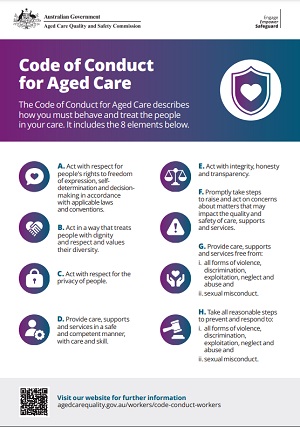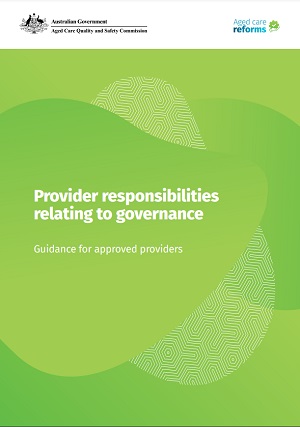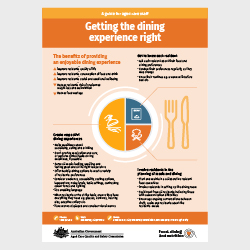The case studies for approved providers and their workers have been designed to inform and educate the workforce about the 8 elements of the Code of Conduct for Aged Care (the Code). A range of case studies provide examples both consistent and inconsistent with the Code.

The case studies for consumers have been designed to inform consumers and their families about the new Code of Conduct for Aged Care (the Code). The resource explores the 8 elements of the Code, listing some examples of expected behaviour for each element, as well as a case study example.

This poster provides a quick introduction to the new Code of Conduct for Aged Care (the Code). It includes a weblink and QR code to find out more on the Aged Care Quality and Safety Commission’s website.

In this fact sheet, the Commission addresses the expectation that providers will have appropriate and robust workforce governance and management processes in place to ensure consumers have continuity of safe and quality care and services in anticipation of any external workforce pressures.

This resource is a guide to specific responsibilities for approved providers in relation to their governance arrangements.

This resource is a goal planning tool designed to support aged care providers in improving food, dining, nutrition, and consumer choice. It helps providers set objectives, track progress, and implement actions to enhance service quality, ensuring that people’s preferences and dietary needs are consistently met. This resource may refer to information that will be updated from 1 July 2025 to align with the new Aged Care Act and Quality Standards.

On Friday 26 August, the Aged Care Quality and Safety Commissioner, Ms Janet Anderson, PSM, sent a letter to approved providers regarding the SCHADS Award.

This fact sheet outlines what you and your care team can do to make your dining experience enjoyable.
The dining experience includes the food and drinks provided, the service you receive and the atmosphere. A good dining experience improves your wellbeing and increases your quality of life.

This fact sheet helps aged care residents communicate their food and dining preferences. It includes sections for meal choices, dining preferences, assistance needs, health considerations, cultural or religious customs, and contact information for allied health professionals. It also advises staff to monitor changes in weight and contact a dietitian if needed.
This resource may refer to information that will be updated from 1 July 2025 to align with the new Aged Care Act and Quality Standards.

This poster is a guide for aged care residents about what you should expect from your provider and dining team for an enjoyable meal and dining experience.

This fact sheet provides practical tips for enhancing dining experiences in residential aged care settings. It offers guidance on food presentation, meal assistance, creating a respectful and enjoyable atmosphere, supporting independence, and providing culturally appropriate dining options. The aim is to improve mealtime satisfaction while maintaining older peoples' dignity and people's preferences. This resource may refer to information that will be updated from 1 July 2025 to align with the new Aged Care Act and Quality Standards.

This poster is a guide for aged care staff about how to get the dining experience right for residents.

This poster is a guide for aged care staff about get to know residents so you can support them to have meaningful meal time experiences.

This poster for aged care staff sets out the 8 facts you need to know about the residents you support to:
- ensure residents receive nutritious and appealing meals they can eat
- notice early warning signs of decreased appetite and/or weight loss
- act early to prevent malnutrition.

This fact sheet outlines how providers can create an enjoyable dining experience for residents in aged care to support their consumption of meals, reduce risks of malnutrition and dehydration, and to meet the Aged Care Quality Standards.

This fact sheet outlines how residential aged care staff, including cooks, chefs, food service staff and care staff, can create an enjoyable dining experience to support residents to take pleasure in, and consume, their meals.

This short animation video provides a helpful explanation of what dignity of risk is and a brief overview of what you should expect from your provider.

The Commission has developed a number of resources to help aged care consumers understand what dignity of risk is and what actions you should expect from your provider. The dignity of risk is another way of saying you have the right to live the life you choose.

This video explains what person-centred care means and how you can work with your provider to achieve it.

The poster and video will support you in understanding person-centred care.








